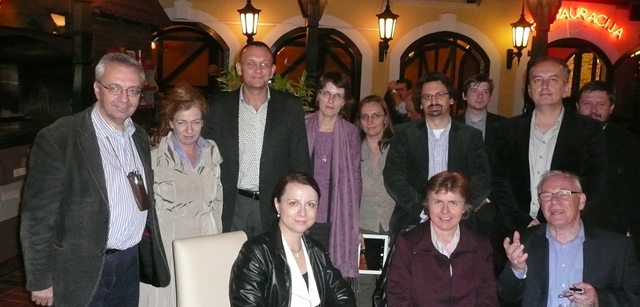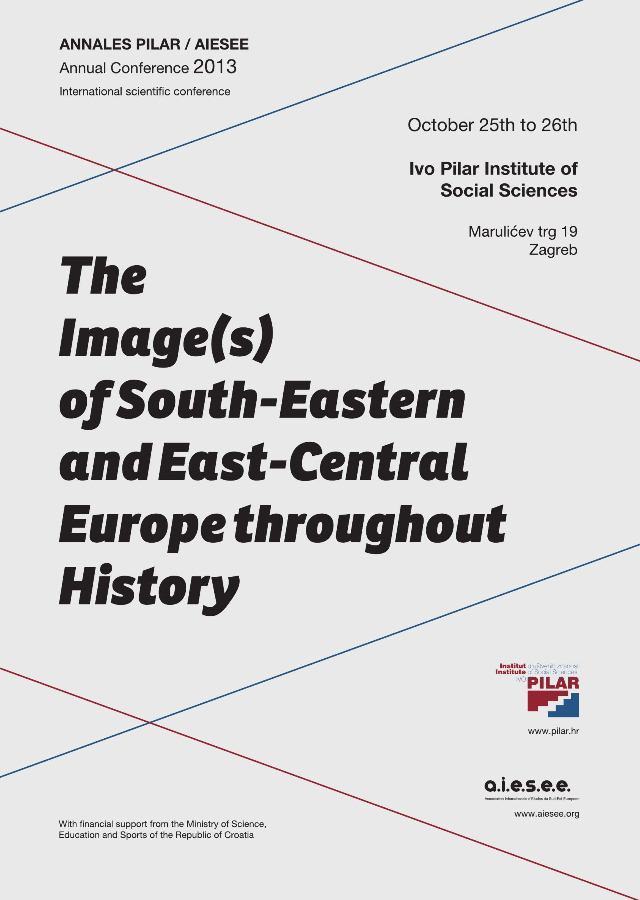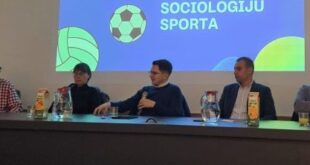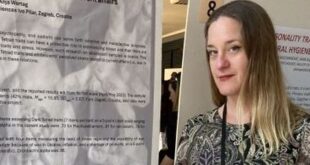U organizaciji Instituta društvenih znanosti Ivo Pilar i Hrvatskog nacionalnog komiteta AIESEE (Association Internationale d’Etudes du Sud-Est Européen/International Association of South-East European Studies) održana je 25. i 26. listopada 2013. u Institutu Ivo Pilar u Zagrebu zajednička međunarodna znanstvena konferenciju AIESEE / ANNALES PILAR 2013. na temu “Predodžba(e) o Jugoistočnoj i Srednjoj Europi kroz povijest” – Program konferencije / Izvješće s konferencije
The “Ivo Pilar” Institute of Social Sciences and the Croatian National Committee of AIESEE (Association Internationale d’Etudes du Sud-Est Européen/International Association of South-East European Studies) organized their joint scientific conference AIESEE / ANNALES PILAR 2013 (October 25th to 26th 2013) – “The Image(s) of South-Eastern and East-Central Europe Throughout History” – Conference Program /Conference Report
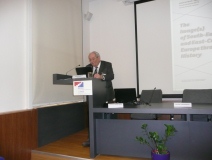 |
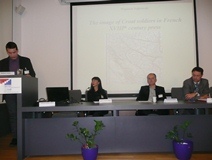 |
 |
– Fotogalerija / Photo gallery
| Predodžba(e) o Jugoistočnoj i Srednjoj Europi kroz povijest “Annales Pilar” godišnja konferencija / AIESEE Annual Conference 25. – 26. listopada 2013., Institut društvenih znanosti Ivo Pilar / Zagreb, Hrvatska |
The Image(s) of South-Eastern and East-Central Europe Throughout History “Annales Pilar” Annual Conference / AIESEE Annual Conference October 25th to 26th, 2013, “Ivo Pilar” Institute of Social Sciences / Zagreb, Croatia |
| – Poziv za sudjelovanje / Opis konferencije – Program konferencije – Izvješće s konferencije |
– Call for Papers / Conference Description – Conference Program – Conference Report |
Nakon pada komunizma, velik dio regije poznate ranije (posebice tijekom Hladnog rata) kao Istočna Europa političari i znanstvenici konvencionalno su podijelili na Jugoistočnu i Srednju Europu. Radilo se o pokušaju emancipacije regije od utjecaja Rusije i prevladavanja naslijeđa Hladnog rata i njegovih podjela, iako spomenuta dva pojma ne obuhvaćaju uvijek iste realitete. Jugoistočna Europa je, u biti, stariji pojam kojeg su zapadni znanstvenici skovali za Balkan u drugoj polovici 19. stoljeća. Srednja Europa (što nije stara Mitteleuropa, jer ne uključuje Njemačku) pojam je koji se pojavio tek početkom osamdesetih godina 20. stoljeća, i to “iznutra” i u opoziciji prema Sovjetskom Savezu.
Tijekom vremena, u mnogim se akademskim disciplinama razvilo područje istraživanja konstrukcije identiteta u ovim regijama (“Drugi”, u kontekstu opozicije Ja-Drugi). Za rađanje ovog područja istraživanja nisu bili zaslužni samo gore spomenuti politički i povijesni uvjeti, već su ga uvjetovali i širi trendovi u akademskom i kulturnom životu. Tako se, primjerice, proučavala uloga zapadnjaka (Europljana i Amerikanaca) u stvaranju i nametanju identiteta drugima čak i u njihovim vlastitim zemljama, izražavajući komplekse superiornosti i stvarajući kulturne hijerarhije, a u isto vrijeme namjerno ili nenamjerno pokušavajući uspostaviti i održati kontrolu nad onima koje se karakterizira i kategorizira. U tom kontekstu valja spomenuti takozvani orijentalizam i balkanizam koje su formulirali Eduard Said i Maria Todorova, zajedno s radovima Larryja Wolffa, Milice Bakic-Hayden, Vesne Goldsworthy i drugih. Csaba Dupcsik označio je ovaj niz studija skupno kao kritiku “euroorijentalizma”. Ipak, posljednjih godina je nekolicina autora (Richard Andrew Hall, Tony Judt, Misha Glenny i drugi) kritički pisala o gore spomenutim tezama, a njihovi su radovi imali za cilj dekonstrukciju kritike “euroorijentalizma”.
Posljedično, jedan od ciljeva predloženog projekta jest priključiti se ovoj vrlo važnoj raspravi u znanosti o Istočnoeuropljanima (“Druga Europa”), između kritike “euroorijentalizma” i njezinih protivnika te ju obogatiti vlastitim istraživačkim rezultatima. Također se namjerava uzeti u obzir “obrnutu perspektivu”: predodžbu(e) o Zapadu, o “Europi”, u Srednjoj i Jugoistočnoj Europi. Ova tema, koja zemlje i narode koji pripadaju ovim regijama promiče u aktere, postala je vrlo relevantna posljednjih godina, posebice zbog integracije dijela njih u Europsku Uniju. Treća perspektiva koju predlaže projekt jest ona zemalja regije o njoj samoj. Postoje razlozi za pretpostaviti, barem kao radna hipoteza, da se gledanje na regiju razlikuje od zemlje do zemlje, nudeći uvid u zanimljive razloge tih razlika te u predodžbe i stereotipe o svojim susjedima. I konačno, ali ne i najmanje važno, bilo bi zanimljivo saznati o predodžbi(ama) o spomenutim regijama u zemljama dalje na istoku, u Rusiji i Japanu.
Cilj konferencije jest i pokušaj olakšavanja razmjene znanja i ideja između različitih znanstvenika koji se bave Srednjom i Jugoistočnom Europom, kao i pomoć istraživačima u održavanju postojećih ili uspostavi novih suradničkih veza preko granica pojedinih disciplina. Drugim riječima, namjerava se pomoći u gradnji mostova povjerenja između različitih zajednica u Srednjoj i Jugoistočnoj Europi, kao i između ovih regija/ove regije i drugih područja: Zapadne Europe, Rusije i Japana, izdižući se iznad negativnih stereotipa, ideologija i političkih režima, a u duhu demokracije i pluralizma.
Objava istraživačkih rezultata i njihova daljnja diseminacija u društvu također je sastavni dio ovog međunarodnog znanstvenog projekta/konferencije.
Prihvaćamo priloge zasnovane na izvornom istraživanju, kao i pregledne članke i kritičke/teorijske pristupe. Izlaganja će biti ograničena na 15 minuta. Sažeci ne bi trebali prelaziti jednu karticu teksta (oko 350 riječi) i treba ih predati do 15. prosinca 2012. godine. Autore prihvaćenih izlaganja obavijestit će se o tomu koncem siječnja 2013. godine. Svi prilozi moraju biti napisani na engleskom ili na francuskom jeziku. Sažetke i detalje o autorovoj/autoričinoj pripadnosti pojedinim institucijama treba predati u Wordu prema ovom redoslijedu: 1) autor(i); 2) institucija; 3) e-mail adresa; 4) naslov sažetka; 5) sažetak. Organizacijski i Programski odbor konferencije potvrdit će prijem vaših predloženih priopćenja i odgovorit će na sve podnesene prijedloge.
Izabrana izlaganja s konferencije naknadno će se objaviti kao njezin zbornik radova, nakon postupka dvostruke recenzije i prema dogovorenom rasporedu objave. Svi radovi izabrani za objavu moraju biti izvorni i ne smiju biti već negdje drugdje objavljeni.
Za najnovije informacije o konferenciji kontaktirajte:
dr. sc. Castilia Manea-Grgin (koordinatorica konferencije i predsjednica Hrvatskog nacionalnog odbora AIESEE)
Institut društvenih znanosti Ivo Pilar,
Marulićev trg 19/I, 10000 Zagreb, Hrvatska
Tel.: (+) 385 1 4886-804
Fax: (+) 385 1 4828-296
E-mail adresa: castilia.grgin@pilar.hr
POZIV ZA SUDJELOVANJE ZA OVAJ SKUP BIO JE ZATVOREN 15. PROSINCA 2012.
Zajedničku ANNALES PILAR/AIESEE godišnju konferenciju 2013., The Image(s) of South-Eastern and East-Central Europe throughout History („Predodžba(e) o jugoistočnoj i srednjoj Europe tijekom povijesti“) organizirao je Institut društvenih znanosti Ivo Pilar u suradnji s Hrvatskim nacionalnim odborom AIESEE-a (Association Internationale d’ Etudes du Sud – Est Européen/International Association for Southeast European Studies, sa sjedištem u Bukureštu). Međunarodni znanstveni skup održan je 25. i 26. listopada u Institutu Ivo Pilar, u godini kada se slavi 50. godišnjica utemeljenja AIESEE pri UNESCO-u. Nažalost, jedina institucija koja je izravno financijski podržala konferenciju jest Ministarstvo znanosti, obrazovanja i sporta Republike Hrvatske.
Naši počasni gosti bili su Njegova ekscelencija, g. Cosmin George Dinescu, rumunjski ambasador; zamjenik šefa misije u Veleposlanstvu Rumunjske u Zagrebu, g. Florian Antohi i gđa Miljenka Kuhar, načelnica Odjela za znanstvene i tehnološke projekte u Upravi za znanost i tehnologiju MZOS-a RH. Skup su pozdravili Nj.E. g. Cosmin George Dinescu, gđa Miljenka Kuhar; akademik Răzvan Theodorescu, generalni tajnik AIESEE-a te prof. dr. sc. Vlado Šakić, ravnatelj Instituta Ivo Pilar. Prof. dr. sc. Ljiljana Kaliterna Lipovčan, pomoćnica ravnatelja Instituta Ivo Pilar, bila je također prisutna.
Imali smo velik odaziv – oko 35 delegata koji predstavljaju nacionalne odbore AIESEE-a, odnosno akademije, sveučilišta, znanstvene institute iz 11 zemalja (najveći ANNALES PILAR do sada). Na našem skupu sudjelovali su stručnjaci iz raznih disciplina: povjesničari, povjesničari umjetnosti, antropolozi i etnografi, povjesničari književnosti, filolozi, sociolozi i, posljednje ali ne i najmanje važno, demografi. Pogledi na jugoistočnu i srednju Europu izloženi na konferenciji bili su višestruki: oni sa Zapada, iz Rusije i Japana, iz samih zemalja regije(a) o njihovim susjedima i sl. Imali smo i posebnu sekciju o “obrnutoj perspektivi”: predodžba (e) o Zapadu u jugoistočnoj i srednjoj (odnosno istočnoj) Europi.
Prema tome, imali smo dva plodna dana s dobrom razmjenom znanja te poticajnim i otvorenim diskusijama tako da možemo reći da smo ispunili ciljeve konferencije. Dobili smo, također, vrlo zanimljiv uvid u tematiku skupa te mislimo da će ova konferencija, a i zbornik radova, biti važan orijentir u istraživanju jugoistočne i srednje Europe. Akademik Răzvan Theodorescu, generalni tajnik AIESEE-a, službeno je pohvalio našu konferenciju kao najbolji skup AIESEE-a posljednjih dvadeset godina. I naposljetku, nadamo se da su sudionici bili zadovoljni i neformalnim, ne samo intelektualnim aspektom konferencije.
After the fall of communism, a large part of the region formerly known (primarily during the Cold War) as „Eastern Europe“ was conventionally divided by scholars and politicians in South-East and East-Central Europe. It was an attempt to emancipate the region from Russia and to overcome the legacy of the Cold War and its divisions, even though these two terms do not cover always the same realities. „South-East Europe“ is in fact an older term coined for the Balkans in the second half of the nineteenth century by Western scholars. “Central Europe“ (which is not the old Mitteleuropa because it does not include Germany) emerged only at the beginning of the 1980’s „from the inside“ and in opposition with the Soviet Union.
Over the years, there has developed a growing subfield across many academic disciplines that examines the construction of identities in the region („the Other“, in the context of a Self-Other opposition). The birth of this subfield is due not only to the above mentioned political/historical conditions, but also lies in broader academic and cultural trends. These trends, for example, look at the role of Western Europeans and North-Americans in creating and imposing identities upon „others“, even in their home countries, by expressing superiority complexes and creating cultural hierarchies, at the same time wittingly and unwittingly aiming to establish and maintain control over those they characterize and categorize. It should be mentioned in this context the so-called „Orientalism“ and “Balkanism”, identified by Eduard Said and Maria Todorova, respectively, along with the works of Larry Wolff, Milica Bakic-Hayden, Vesna Goldsworthy, etc. Csaba Dupcsik has dubbed this set of studies collectively as a critique of „Euro-Orientalism“. However, in recent years some scholars (Richard Andrew Hall, Tony Judt, Misha Glenny, etc.) have been critical of the above mentioned theses and their works aim at deconstructing the critique of „Euro-Orientalism“.
Consequently, one of the aims of the proposed project is to insert itself in this very relevant debate on East Europeans („the Other Europe“) between the critique of „Euro-Orientalism“ and its opponents and to enrich it with its own results. It is intended to also take into consideration „the inverted perspective“: the image(s) of the West, of “Europe” in SEE and East-Central Europe. This topic, which turns the countries belonging to this region/these regions into actors, has become quite relevant over the last years, particularly because of the integration of a part of them into the European Union. The third perspective proposed by the project is that of the countries of South-East and East-Central Europe themselves on their region(s). There is reason to assume, at least as a working hypothesis that the view on the region differs from country to country, offering insight in the interesting reasons of those differences and in the images and stereotypes of their neighbors. Last but not least, it would be interesting to learn about the image(s) of the above mentioned regions created more towards the East, namely in Russia and Japan.
The conference aims to facilitate the exchange of knowledge and ideas between scholars dealing with South-East and East-Central Europe as well as to help researchers maintain collaborative links across disciplines or establish new ones. In other words, it is intended to help building bridges of confidence between the different communities of SEE and East-Central Europe as well as between this region/these regions and other areas: Western Europe, Russia, Japan, rising above negative stereotypes, ideologies and political regimes in the spirit of democracy and pluralism.
Publication of the research results and their further dissemination in the society is an integral part of this international scientific project/conference. We welcome contributions based on original research as well as literature reviews and critical/theoretical approaches. Papers will be limited to 15 minutes. Abstracts should not exceed one page (approximately 350 words) and should be submitted by December 15, 2012. The selected authors will be notified by the end of January 2013. All contributions must be written in English or French. Abstracts and the institutional affiliation details should be submitted in Word following this order: 1) author (s); 2) affiliation; 3) e-mail address; 4) title of abstract; 5) body of abstract. The Organizing and Program Planning Committee will acknowledge the receipt of your proposal and answer to all paper proposals submitted.
A selection of the papers presented at the conference will be subsequently published in the form of conference proceedings, after a double peer-review process based on an agreed publication schedule. All the papers selected for publication should be original and must not have been published elsewhere.
For the latest information concerning the conference contact:
Dr. Castilia Manea-Grgin (Conference Coordinator and President of the Croatian National Committee of AIESEE)
„Ivo Pilar“ Institute of Social Sciences,
Marulićev trg 19/I, 10000 Zagreb, Croatia
Tel.: (+) 385 1 4886-804
Fax: (+) 385 1 4828-296
E-mail address: castilia.grgin@pilar.hr
We look forward to seeing you at the conference.
THE CALL FOR PAPERS FOR THIS CONFERERENCE WAS CLOSED ON DECEMBER 15, 2012.
Conference Report
The joint Annales Pilar /AIESEE Annual Conference 2013, The Image(s) of South-Eastern and East-Central Europe throughout History, was organized by the Ivo Pilar Institute of Social Sciences in collaboration with the Croatian National Committee of AIESEE (Association Internationale d’Etudes du Sud-Est Europeen/International Association for Southeast European Studies, based in Bucharest). This international scientific conference was held at the Ivo Pilar Institute on October 25-26, in the year when the 50th anniversary of AIESEE’s founding at the UNESCO is being celebrated. Unfortunately, the only institution which directly supported the meeting was the Ministry of Science, Education, and Sports of the Republic of Croatia.
Our guests of honour were His Excellency, Mr. Cosmin George Dinescu, the Romanian Ambassador; the Deputy Head of Mission at the Embassy of Romania in Zagreb, Mr. Florian Antohi; and Ms. Miljenka Kuhar, Head of the Department for Science and Technology Projects within the Directorate for Science and Technology of the MSES of the Republic of Croatia. The conference delegates and the audience were greeted by His Excellency, Mr. Cosmin George Dinescu; Ms. Miljenka Kuhar; Academician Răzvan Theodorescu, the Secretary General of AIESEE; and Prof. Vlado Šakić, the Director of the Ivo Pilar Institute of Social Sciences. Prof. Ljiljana Kaliterna Lipovčan, the Deputy Director of the Ivo Pilar Institute, was also present.
We had a large turnout at the conference – about 35 delegates representing AIESEE national committees as well as academies, universities, scientific institutes from 11 countries (the largest conference ANNALES PILAR ever). Experts from various disciplines participated in the meeting: historians, historians of art, anthropologists and ethnographers, historians of literature, philologists, sociologists, and, last but not least, demographers. The perspectives on South-East and East-Central Europe proposed by the conference were multiple: those of the West, Russia or Japan, of the countries from the region(s) themselves on their neighbours, etc. We also had a special session on the „inverted perspective“: the image(s) of the West in South-Eastern and East-Central Europe.
Consequently, we had two fruitful days with good exchange of knowledge and stimulating as well as open discussions, and we can claim that we fulfilled our conference goals. We got a deep and very interesting insight in the tematics of our meeting, and we think that this conference and its proceedings will be an important landmark in the studies of our South-Eastern and East-Central Europe. Academician Răzvan Theodorescu, Secretary General of AIESEE, formally commended our conference as the best meeting of this association in the last twenty years. On the other hand, we hope that the social side of the event was no less satisfying than the intellectual aspect.

 Institut društvenih znanosti Ivo Pilar Pilar
Institut društvenih znanosti Ivo Pilar Pilar
